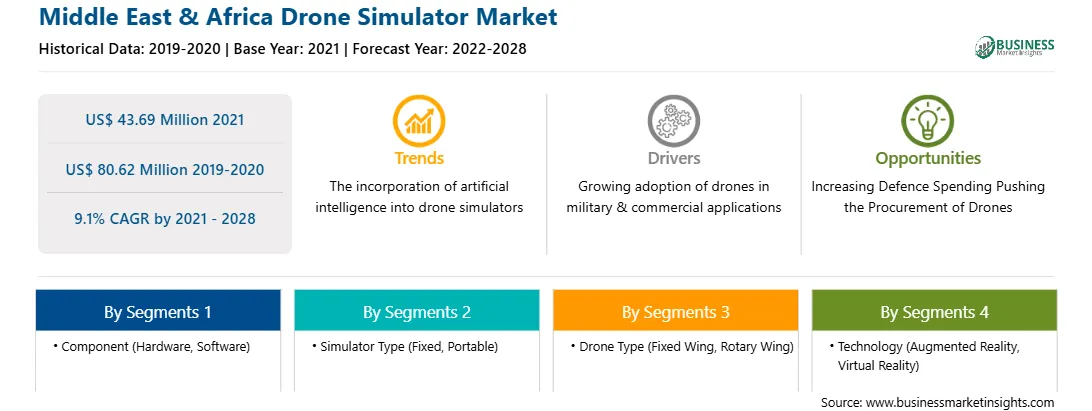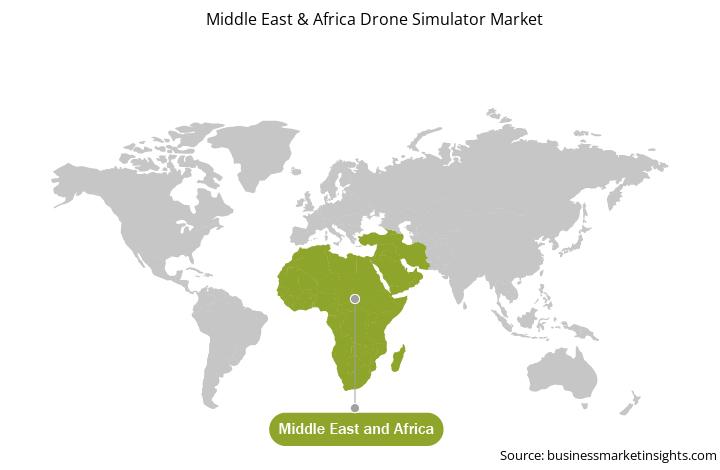The MEA comprises various well-established economies, such as South Africa, the UAE, and Saudi Arabia. The military sector in many Middle East countries is in the growth stage; thus, they are putting greater efforts to enhance the strength of their military forces. As per the Global Firepower website data, Egypt, Turkey, Israel, Saudi Araba, and Iran are among the prominent countries in the region with good military strength. Besides, government bodies are making massive investments in strengthening their respective armed forces. According to the International Institute for Strategic Studies (IISS), Saudi Arabia is a country with the largest military investments in the region. Riyadh's defense budget was more than the combined budget of the next five biggest spenders (Israel, Iraq, Algeria, Iran, and Oman) in the MEA. Substantial military investments enable these countries to adopt advanced technologies, such as drone simulators. According to SIPRI data, in 2020, South Africa, Saudi Arabia, and the UAE invested US$ 3,151 million, US$ 57,519 million, and US$ 17,725, respectively, in the efforts to strengthen their military forces.
The MEA drone simulator market is majorly affected by disruptions in supply chains during the COVID-19 pandemic. This is mainly ascribed to the closed borders of countries. Further, the demand for drones decreased in 2020 in the MEA countries. This has resulted in the loss of businesses of drone simulator manufacturers offering their products to end users in the MEA. Moreover, the demand for advanced drone components, including various types of portable drone simulator for military drone fleet and commercial aviation fleet among the drone manufacturers, military forces, and MRO service providers, decreased significantly in 2020.

Strategic insights for the Middle East & Africa Drone Simulator provides data-driven analysis of the industry landscape, including current trends, key players, and regional nuances. These insights offer actionable recommendations, enabling readers to differentiate themselves from competitors by identifying untapped segments or developing unique value propositions. Leveraging data analytics, these insights help industry players anticipate the market shifts, whether investors, manufacturers, or other stakeholders. A future-oriented perspective is essential, helping stakeholders anticipate market shifts and position themselves for long-term success in this dynamic region. Ultimately, effective strategic insights empower readers to make informed decisions that drive profitability and achieve their business objectives within the market.

| Report Attribute | Details |
|---|---|
| Market size in 2021 | US$ 43.69 Million |
| Market Size by 2028 | US$ 80.62 Million |
| Global CAGR (2021 - 2028) | 9.1% |
| Historical Data | 2019-2020 |
| Forecast period | 2022-2028 |
| Segments Covered |
By Component
|
| Regions and Countries Covered | Middle East and Africa
|
| Market leaders and key company profiles |
The geographic scope of the Middle East & Africa Drone Simulator refers to the specific areas in which a business operates and competes. Understanding local distinctions, such as diverse consumer preferences (e.g., demand for specific plug types or battery backup durations), varying economic conditions, and regulatory environments, is crucial for tailoring strategies to specific markets. Businesses can expand their reach by identifying underserved areas or adapting their offerings to meet local demands. A clear market focus allows for more effective resource allocation, targeted marketing campaigns, and better positioning against local competitors, ultimately driving growth in those targeted areas.

The drone simulator market in MEA is expected to grow from US$ 43.69 million in 2021 to US$ 80.62 million by 2028; it is estimated to grow at a CAGR of 9.1% from 2021 to 2028. Since more than a decade, armed forces from several countries have been using drones. Ground troops are employing small drones regularly. Military spending on unmanned aerial vehicles (UAVs) is rising as a fraction of overall military spending, which is propelling the growth of specialist drone manufacturers and simulator software developers. Several drones are being developed specifically for surveillance purposes. Some drones, on the other hand, have been developed for vital missions, such as transporting weapons. Countries such as UAE and Azerbaijan utilize remotely controlled unmanned aerial vehicles (UAVs) to carry weapons for defense forces. Furthermore, drones are employed as loitering weapons. Drones are also employed in real-time to collect data on ongoing and life-threatening military missions using their intelligence, surveillance, and reconnaissance (ISR) capabilities. Hence, the demand for drone simulators is increasing as a result of the factors listed above.
MEA drone simulator market is segmented into component, simulator type, drone type, technology, and country. Based on component, the MEA drone simulator market is bifurcated into hardware and software. Hardware segment held the largest market share in 2020. Based on simulator type, the MEA drone simulator market is bifurcated into fixed and portable. Fixed segment held the largest market share in 2020. Based on drone type, MEA drone simulator market is bifurcated into fixed wing and rotary wing. Fixed wing segment held the largest market share in 2020. Similarly based on technology the MEA drone simulator market is bifurcated into augmented reality and virtual reality. Virtual reality segment held the largest market share in 2020. Based on country, the MEA drone simulator market is segmented into Saudi Arabia, South Africa, UAE, and rest of MEA. UAE held the largest market share in 2020.
A few major primary and secondary sources referred to for preparing this report on the drone simulator market in MEA are company websites, annual reports, financial reports, national government documents, and statistical database, among others. Major companies listed in the report are CAE Inc.; HAVELSAN A.S.; Israel Aerospace Industries Ltd.; L3Harris Technologies, Inc.; Leonardo S.p.A.; SIMLAT UAS SIMULATION; and SINGAPORE TECHNOLOGIES ELECTRONICS LIMITED.
The Middle East & Africa Drone Simulator Market is valued at US$ 43.69 Million in 2021, it is projected to reach US$ 80.62 Million by 2028.
As per our report Middle East & Africa Drone Simulator Market, the market size is valued at US$ 43.69 Million in 2021, projecting it to reach US$ 80.62 Million by 2028. This translates to a CAGR of approximately 9.1% during the forecast period.
The Middle East & Africa Drone Simulator Market report typically cover these key segments-
The historic period, base year, and forecast period can vary slightly depending on the specific market research report. However, for the Middle East & Africa Drone Simulator Market report:
The Middle East & Africa Drone Simulator Market is populated by several key players, each contributing to its growth and innovation. Some of the major players include:
The Middle East & Africa Drone Simulator Market report is valuable for diverse stakeholders, including:
Essentially, anyone involved in or considering involvement in the Middle East & Africa Drone Simulator Market value chain can benefit from the information contained in a comprehensive market report.